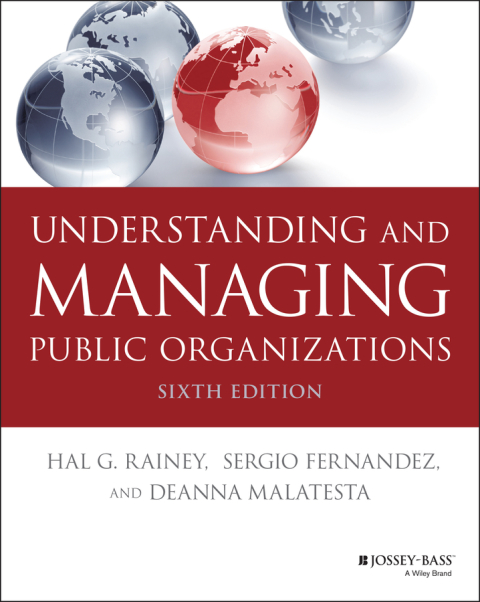Description
Efnisyfirlit
- COVER
- TITLE PAGE
- COPYRIGHT
- FIGURES AND TABLES
- PREFACE
- Audience
- Organization
- Acknowledgments
- THE AUTHORS
- PART ONE: THE DYNAMIC CONTEXT OF PUBLIC ORGANIZATIONS
- CHAPTER ONE: THE CHALLENGE OF EFFECTIVE PUBLIC ORGANIZATION AND MANAGEMENT
- Toward Improved Understanding and Management of Public Organizations
- General Management and Public Management
- Ineffective Public Management?
- Effective Public Management
- Organizations: A Definition and a Conceptual Framework
- Instructor’s Guide Resources for Chapter One
- Notes
- CHAPTER TWO: UNDERSTANDING THE STUDY OF ORGANIZATIONS: A HISTORICAL REVIEW
- The Systems Metaphor
- Classical Approaches to Understanding Organizations
- Reactions, Critiques, and Subsequent Developments in Analysis of Organizations and the People in Them
- More Recent Developments in Organization Theory and Research
- The Role of Public and Nonprofit Organizations and Their Management in Organization Theory
- Instructor’s Guide Resources for Chapter Two
- CHAPTER THREE: WHAT MAKES PUBLIC ORGANIZATIONS DISTINCT
- The Generic Tradition in Organization Theory
- The Importance of Avoiding Oversimplification
- Public Organizations: An Essential Organization/Distinction
- The Meaning and Nature of Public Organizations and Public Management
- Problems and Approaches in Public–Private Comparisons
- Common Assertions About Public Organizations and Public Management
- Instructor’s Guide Resources for Chapter Three
- Note
- CHAPTER FOUR: ANALYZING THE ENVIRONMENT OF PUBLIC ORGANIZATIONS
- General Dimensions of Organizational Environments
- Research on Environmental Variations
- Recent Trends in Research on Organizational Environments
- The Political and Institutional Environments of Public Organizations
- Instructor’s Guide Resources for Chapter Four
- CHAPTER FIVE: THE IMPACT OF POLITICAL POWER AND PUBLIC POLICY
- Instructor’s Guide Resources for Chapter Five
- PART TWO: KEY DIMENSIONS OF ORGANIZING AND MANAGING
- CHAPTER SIX: ORGANIZATIONAL GOALS, EFFECTIVENESS, AND PERFORMANCE
- General Organizational Goals
- Goals of Public Organizations
- Behavioral Theories of Organizational Decision Making: Changing Perspectives on Organizational Goals
- Toward Diverse, Conflicting Criteria
- Approaches to Organizational Effectiveness
- Effectiveness in Organizational Networks
- Managing for High Performance
- Instructor’s Guide Resources for Chapter Six
- Notes
- CHAPTER SEVEN: FORMULATING AND ACHIEVING PURPOSE: POWER, DECISION MAKING, AND STRATEGY
- Power and Politics Inside Organizations
- Decision Making in Organizations
- Strategic Management
- The Miles and Snow Typology
- Issues for Managers and Researchers
- Instructor’s Guide Resources for Chapter Seven
- CHAPTER EIGHT: ORGANIZATIONAL STRUCTURE, DESIGN, TECHNOLOGY, INFORMATION TECHNOLOGY, AND SOCIAL MEDIA
- Do Public Organizations Have Distinctive Structural Characteristics?
- The Development of Research on Structure
- Structural Dimensions and Influences
- Organizational Design
- Major Design Alternatives
- Organizational Structures in Public Organizations
- Information Technology and Public Organizations
- Social Media and Public Management
- Instructor’s Guide Resources for Chapter Eight
- CHAPTER NINE: UNDERSTANDING PEOPLE IN PUBLIC ORGANIZATIONS: MOTIVATION AND MOTIVATION THEORY
- Motivation and Public Management
- The Context of Motivation in Public Organizations
- The Concept of Work Motivation
- Motivation Practice and Techniques
- Incentive Structures and Reward Expectancies in Public Organizations
- Self-Reported Motivation Among Public Employees
- Instructor’s Guide Resources for Chapter Nine
- CHAPTER TEN: UNDERSTANDING PEOPLE IN PUBLIC ORGANIZATIONS: VALUES, INCENTIVES, AND WORK-RELATED ATTITUDES
- Attempts to Specify Needs, Values, and Incentives
- Other Important Work-Related Attitudes
- Motivation-Related Variables in Public Organizations
- Representative Bureaucracy: Why the Social Origins of Public Employees Matter
- Workforce Diversity
- The Challenge of Stimulating Motivation and Positive Work Attitudes in Public Organizations
- Instructor’s Guide Resources for Chapter Ten
- Note
- CHAPTER ELEVEN: LEADERSHIP, MANAGERIAL ROLES, AND ORGANIZATIONAL CULTURE
- Leadership Theories in Management and Organizational Behavior
- The Nature of Managerial Work and Roles
- Transformational Leadership
- Charismatic Leadership
- Leadership and Organizational Culture
- Leading Cultural Development
- Leadership and Management in Public Organizations
- Does Context Affect Performance and Behavior?
- Effective Leadership in Government
- Instructor’s Guide Resources for Chapter Eleven
- CHAPTER TWELVE: TEAMWORK: UNDERSTANDING COMMUNICATION AND CONFLICT IN GROUPS
- Groups in Organizations
- Communication in Organizations
- Conflict in Organizations
- Managing Groups, Communication, and Conflict in Organizations
- Special Considerations for Public Organizations
- Instructor’s Guide Resources for Chapter Twelve
- PART THREE: STRATEGIES FOR MANAGING AND IMPROVING PUBLIC ORGANIZATIONS
- CHAPTER THIRTEEN: MANAGING ORGANIZATIONAL CHANGE AND DEVELOPMENT
- Relatively Natural Change: Organizational Life Cycles
- Large-Scale Planned Change
- Organization Development
- Success and Failure in Large-Scale, Planned Organizational Change
- Instructor’s Guide Resources for Chapter Thirteen
- CHAPTER FOURTEEN: ADVANCING PUBLIC MANAGEMENT THROUGH COLLABORATION
- Reform Movements: Forerunners to Collaborative Governance
- From NPM to Collaborative Governance
- The Literature on Collaboration
- Instructor’s Guide Resources for Chapter Fourteen
- Notes
- REFERENCES
- NAME INDEX
- SUBJECT INDEX
- END USER LICENSE AGREEMENT






Reviews
There are no reviews yet.